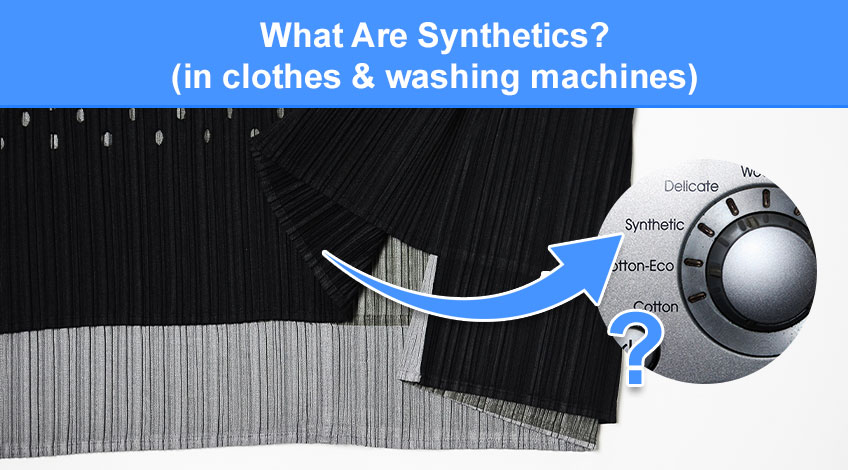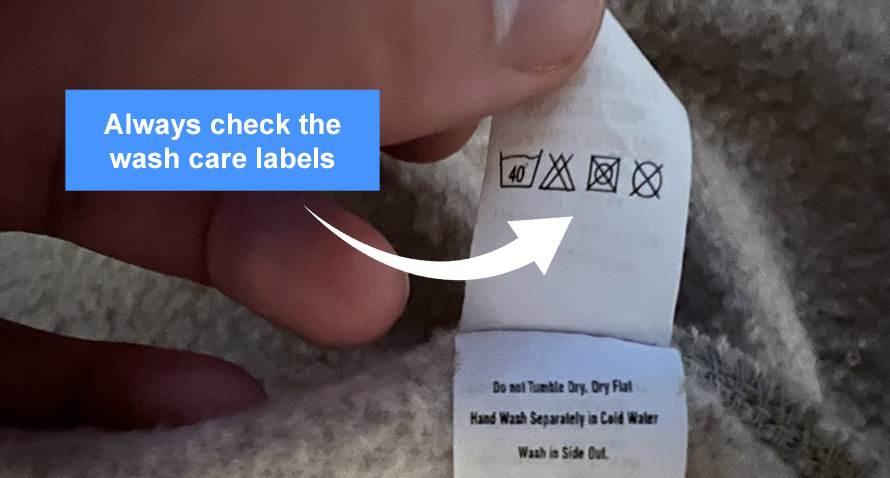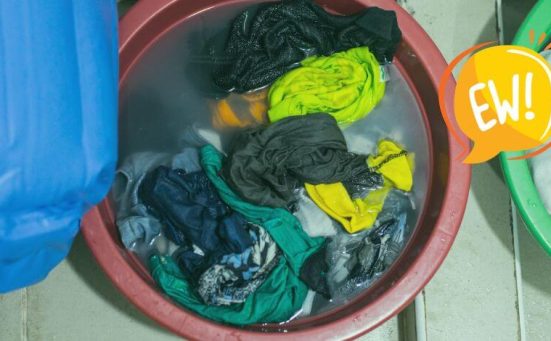
What Are Synthetics? (in clothes & washing machines)
If you own or use a washing machine you’ll have noticed the synthetics program. But what exactly are synthetics? What type of clothes are they found in? And what’s so special about the synthetic wash cycle?
In this article we look at synthetics and answer all of the above questions and more. If you’ve ever wondered about synthetics, keep reading.
What Are Synthetic Clothes?

Clothes used to be made from all natural materials like cotton from the cotton plant, wool from animal fur and so on. But around the mid 20th century manufacturers started developing fabrics from chemical based substances.
Mainly derivatives of the petrochemical industry, synthetic fabrics make up around 62% of all fibres produced every year. With most of those products produced in China.
By artificially manipulating the synthetic material’s composition, clothes can be designed for specific purposes like sportswear and swimwear for example.
So in summary, “synthetic clothes” are clothes that are made from a composite of man-made materials.
What Are The Main Types Of Synthetic Fibres Used In The Clothing Industry?
Since they were first introduced in the 1940s, the development of synthetic fabrics has increased to include many materials used to make lots of our clothes.
Materials like;
- Polyester
Polyester was first produced in the UK during the 1940s but became popular in the US during the 1970s disco era. It is the most popular man made fabric in the world mainly due to its low production costs and subsequent low price tag. Polyester is a versatile, crease resistant material which is often blended with cotton or other synthetic materials. - Elastane
Also known as spandex or under the brand name Lycra, elastane is a synthetic elastic material that is used in clothing to allow it to stretch. Elastane fibres can stretch up to 7 times their original size and is usually blended with cotton to make sportswear. - Nylon
Nylon is another well known synthetic material which is used to make stockings, lingerie, shirts, swimwear, sportswear and cycling apparel. It is a strong material known to be elastic and able to withstand friction and tension which makes it a perfect material for clothes made for sporting activities. - Acrylic
Acrylic is a synthetic wool alternative which is machine washable. It was developed during the 1950s and is still used to produce knitwear to this day. It is comfortable and lightweight and yet durable enough to be worn on a daily basis. It feels like wool but is less breathable. - Acetate
Acetate is made from plant cellulose and is a semi synthetic material because it has to be chemically produced. It is similar to silk but is reactive to high temperatures and should not be washed using water. It is used to make dresses, lingerie and blouses and is a less expensive alternative to silk. - Rayon
Although rayon is made from plant based cellulose it is still a synthetic material or semi-synthetic material because it takes a chemical process to produce it. It is used as a silk alternative and can be made into anything traditionally made from silk. - Neoprene
Neoprene is a type of synthetic rubber which is completely waterproof and is therefore ideal for making wetsuits. It is also used to make swimwear, beach shoes, jackets and fishing clothes. - Faux Fur
Faux fur is an ethical alternative to animal fur and is made from a blend of polyester, modacrylic and acrylic fibres. It is a synthetic pile fabric that simulates real animal fur. - Microfibre
Microfibre is made by blending nylon and polyester into a tightly woven yarn. As it is so thin, the material produced is waterproof. This makes it ideal for sportswear as well as jackets and coats. - PVC
Polyvinyl chloride, better known as PVC is a waterproof durable material that is resistant to oil, chemicals and flames. It is used to make protective suits for firefighters and was also used back in the 1960s to make certain items of clothing.
What Synthetic Fabric Is Best For Making Clothes?
Because all synthetic fabrics have different qualities, it is difficult to single any one out as the best for making clothes. For instance neoprene is great for wetsuits but wouldn’t make a very good shirt. Or nylon is great for making stockings but wouldn’t be so great as a knitted sweater.
The best type of synthetic material for clothes very much depends on what the clothes are going to be used for. The requirements of the clothing in question will determine which type of synthetic material is best suited to make it from.
In many cases fabrics are blended to create a more suitable material for example, blending polyester with cotton to make t-shirts.
How To Wash Synthetic Clothes

Different synthetic materials need different ways of being cleaned. Some, like rayon, should be dry cleaned or hand washed only. However there are plenty of synthetic fabrics that can be washed in the washing machine.
With that said, there are a few guidelines that should help to keep your synthetic clothes looking and feeling great for a long time. These include;
- Check the care label
The care label on your garments will give you all the information you need to wash and dry them without causing any damage. - Stick to low temperatures
The majority of synthetic materials are made from plastic polymers which means that subjecting them to high temperatures could lead to them becoming damaged. Certain plastic polymer fabrics could melt if exposed to temperatures that are too high. They should be washed at low temperatures and if tumble dried, it should be on the low heat or no heat setting. - Stick to low spin speeds
When washing synthetic clothes in a washing machine, you should always select a low spin speed, anywhere between 800 to 1000 RPM should be fine. This should prevent any damage to the fabric. Many machines have a synthetic program and this should be used if available. - Limit the release of microplastics
This is an ever increasing problem, all synthetic clothes that are made using plastic polymers release tiny microplastic particles into the water when washed. These microplastics enter the water table and are polluting rivers, oceans and marine life. Reducing the water temperature and spin speed can help to reduce the release of these microplastics.
Microplastics are an unfortunate consequence of using synthetic materials to make clothes. There are other ways to help reduce the release of these harmful pollutants which include;
- Washing only full loads
If the drum is full, the laundry cannot move around so much which reduces the amount of times the clothes collide in the drum. This helps to prevent the microplastics from being released at such a large rate. - Using a shorter cycle
The less time the synthetic materials are in the machine, means less microplastics are released. - Washing synthetics when the really need it
Many synthetic materials can be wiped over to remove stains and airing them can remove some odours. By only washing synthetic clothes when they actually really need it you reduce the amount of microplastics that get released.
What Is A Synthetic Wash Cycle?

As synthetic fabrics become ever more popular, washing machine manufacturers recognise the need for specific programs to wash them. This has led to the majority of washing machines offering a synthetic cycle.
The synthetic cycle on a washing machine tends to be shorter, gentler and at lower temperatures. This makes this cycle ideal for synthetic fabrics as it reduces the amount of damage a more harsh wash cycle would cause.
We’d also like to point out that you should always use a warm wash for synthetic materials.
If the item of synthetic clothing has an ingrained stain, it should be spot treated or soaked before washing in the machine – not put on a longer or hotter wash. You can also buy detergents specifically for synthetic materials.
Should Synthetic Clothes Be Tumble Dried?
Before tumble drying your synthetic clothes you should always consult the care label. In the absence of a care label we would recommend not tumble drying synthetic clothes. However, it is sometimes OK to tumble on a low heat or no heat setting.
The main problem is heat damage and also the material can become damaged by the rough and tumble action of the dryer. That old saying “if in doubt, leave it out” is a very good maxim for tumble drying synthetics.
Why are washing machines so good at what they do?
Because all they do is rinse and repeat! 😂
SEE ALSO:
Frequently Asked Questions
Any clothes made from man made fibres are classed as synthetics. This includes; polyester, nylon, acrylic, rayon, elastane, Lycra, microfibre and many more.
Synthetics on a washing machine refers to materials such as polyester, acrylic or Lycra for example.
10 examples of synthetic fabrics include; polyester, nylon, rayon, neoprene, faux fur, microfibre, elastane, PVC, acetate and acrylic.
Also, follow us on Pinterest ...



